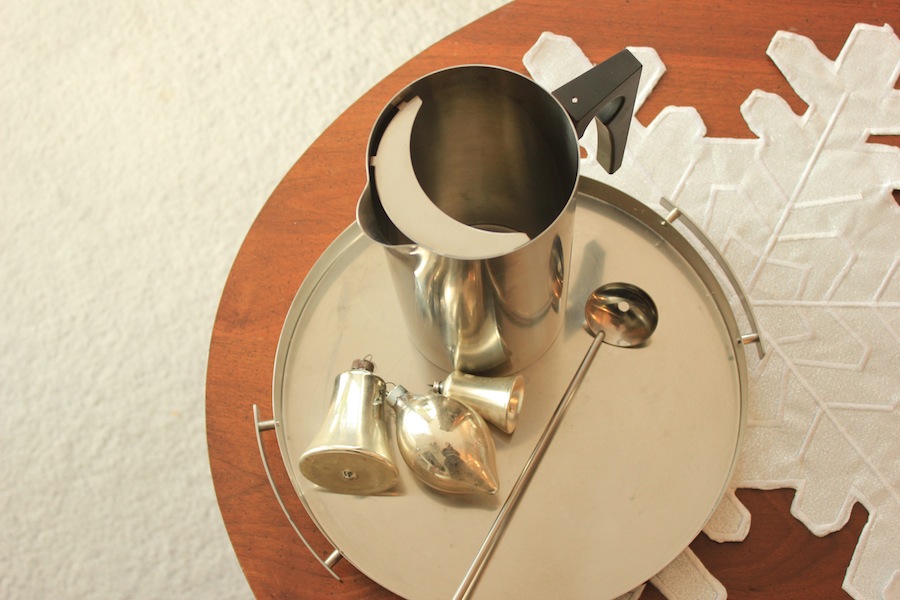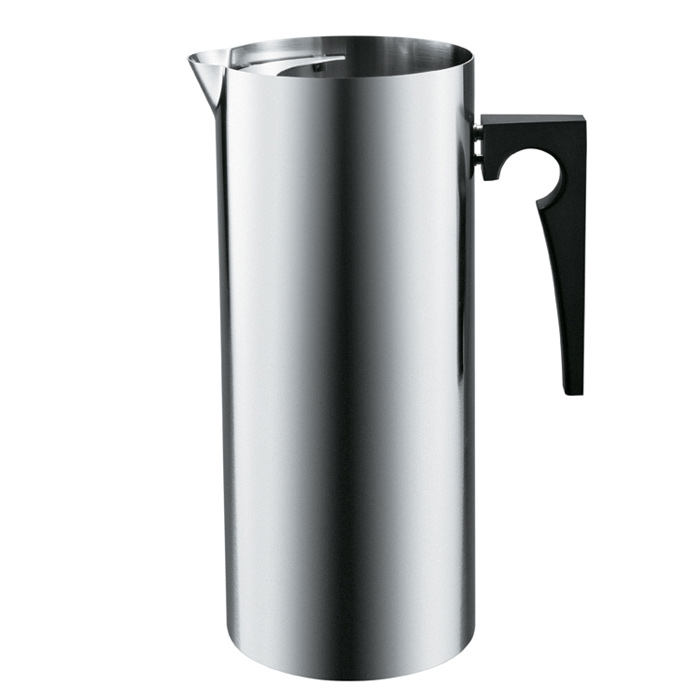Good design is timeless: bullshit
I hear that line all the time. To begin with I believed the hype, then it started to niggle, now my annoyance at that idea has pushed me out of the energy well that I wallow in most of the time and got me to write about it.

Arne Jacobson for Stelton: Cylinda Line water pitcher and tray.
From saf affect
To make this point I’m going to pick, rather unfairly, on Arne Jacobson. It’s not that I think that he’s a particularly bad offender, in fact I don’t think he’s an offender at all. It’s just that this isn’t an academic treatise, just a sketch to get my point across.
When I was writing my thesis I battled through Adaptation in Natural and Artificial Systems and despite using some pretty spectacularly arcane methods of explaining what were already hard concepts, one idea came away from it and stuck with me[1. it might just be that it was particularly hard won but I think it’s a good point nonetheless.]. He expresses it in formal set notation, so I’ll translate:
For each environment there is best fit solution
That’s a pretty lazy way of explaining it, and in trying to explain it in words I can see why he used set notation. Here’s another go, but a bit more verbose:
Given an infinite set of environments, and an infinite set of solutions then for each environment there is a solution that is best adapted to that environment.
That seems pretty ordinary until you consider that in reality the environment is constantly shifting. Most of the time it isn’t changing very much, so natural selection acts to stabilise populations and keep them from changing in a way that would be harmful. Sometimes environments change a lot[1. actually most examples of this are when things are introduced to a new environment.] and natural selection let’s change go into overdrive. JG Ballard uses this to great effect in the drowned world. The changed environment allowed the lizards to grow into giant monsters. Whether Ballard realised that this was potentially legitimate science I have no idea[1. I like to think that he did, he was a smart guy!], but it’s a nice way to think about solutions to specific environments.

There is a link between naturally evolving giant lizards and Arne Jacobson water jugs I promise. Living things, and even systems[1. Systems like the Mousgoum huts that Christopher Alexander talks about in Notes on the Synthesis of Form.] evolve to fit an environment, and I don’t think that it would be too much of a stretch to suggest that when a human designs something that they have a very similar goal in mind. The environment that the designer is targeting will change over time [1. and space if we are thinking about international products, but let’s stick to time being the variable for the moment.], and the fit between product and environment will change.
 When our man Arne was doodling his sketches for the Cylinda set, he was thinking about life in the 50s and 60s, the technology for making things available to him and the fashions that prevailed. He probably had a bunch of other criteria that he was considering too.
When our man Arne was doodling his sketches for the Cylinda set, he was thinking about life in the 50s and 60s, the technology for making things available to him and the fashions that prevailed. He probably had a bunch of other criteria that he was considering too.
As it happens I don’t really like the Cylinda jug and I actively dislike the tray. The tray is hard to pick up, the ‘handles’ are sharp and painful to hold, it’s totally flat on the bottom so if it’s put down on a wet surface it glides around. I’m indifferent to the other parts of this set, but I think that the tray is bad design. I think that bad design really is timeless[1. the only redeeming feature that I can imagine is that he designed the tray for a servant to bring things to the master, and therefore the ergonomics of the tray are irelavent, as long as the master likes the look of it!]. My dislike of the Cylinda set is born out of the different environment that I live in. (I can only assume this, I might have disliked it when it came out!)
Jacobson explicitly designed the set as a reaction to the curvaceous trends of the day, I’ve got one of the jugs in front of me right now. As a jug it’s ok, it pours cleanly and is reasonably well balanced. The choice of plastic for the handle perpetually looks crusty because they’ve faithfully stuck to the polymer technology of the day. The ice lip is spot welded into place so there is plenty of space that can’t be cleaned, but can collect gunge, and has some nice corners that could reward vigorous scrubbing of the interior with fatally slit wrists (the sharp edges thing besets the whole range). Without sounding like a miser I’m not entirely sure where the balance between the $10 kmart knock offs and the $150 genuine article goes; that’s a lot of hand finishing! I think my main objection to the price is that it doesn’t feel like the best we can do for $150 - or industrial machine should be able to do better.
This isn’t an ideal example as there’s not that much that’s changed because we started with a very simple object. There is also the possibility that the brand new jug I have here might be quite different to a 60’s one; maybe the stainless steel is more stainless or easier to work? It feels as if it was originally intended for servants or a housewife to maintain but today they are mainly looked after by administration staff in an office. Whilst the roles have similarities, they don’t have the same mandate and priorities, they don’t have time to hand polish out the endless thumbprints[1. I asked one of the people that looks after the jugs in the office and she said “I don’t like how smudgy they get”. whoever came up with the name “stainless steel” is marketing genius!].
My feelings aren’t really important to the point I’m making. If something really is good design it is designed to fit the needs of people. If the design is intended to be timeless then it needs to fit such a broad range of requirements on any given dimension that it can’t really be ideal (for a specific time) on any dimension.
When I was writing my thesis I battled through Adaptation in Natural and Artificial Systems and despite using some pretty spectacularly arcane methods of explaining what were already hard concepts, one idea came away from it and stuck with me[^1]. He expresses it in formal set notation, so I’ll translate:
For each environment there is best fit solution
That’s a pretty lazy way of explaining it, and in trying to explain it in words I can see why he used set notation. Here’s another go, but a bit more verbose:
Given an infinite set of environments, and an infinite set of solutions then for each environment there is a solution that is best adapted to that environment.
That seems pretty ordinary until you consider that in reality the environment is constantly shifting. Most of the time it isn’t changing very much, so natural selection acts to stabilise populations and keep them from changing in a way that would be harmful. Sometimes environments change a lot[^2] and natural selection let’s change go into overdrive. JG Ballard uses this to great effect in the drowned world. The changed environment allowed the lizards to grow into giant monsters. Whether Ballard realised that this was potentially legitimate science I have no idea[1. I like to think that he did, he was a smart guy!], but it’s a nice way to think [^3]<p>
There is a link between naturally evolving giant lizards and Arne Jacobson water jugs I promise. Living things, and even systems[^4] evolve to fit an environment, and I don’t think that it would be too much of a stretch to suggest that when a human designs something that they have a very similar goal in mind. The environment that the designer is targeting will change over time [1. and space if we are thinking about international products, but let’s stick to time being the variable[^5]<p> When our man Arne was doodling his sketches for the Cylinda set, he was thinking about life in the 50s and 60s, the technology for making things available to him and the fashions that prevailed. He probably had a bunch of other criteria that he was considering too.
When our man Arne was doodling his sketches for the Cylinda set, he was thinking about life in the 50s and 60s, the technology for making things available to him and the fashions that prevailed. He probably had a bunch of other criteria that he was considering too.
As it happens I don’t really like the Cylinda jug and I actively dislike the tray. The tray is hard to pick up, the ‘handles’ are sharp and painful to hold, it’s totally flat on the bottom so if it’s put down on a wet surface it glides around. I’m indifferent to the other parts of this set, but I think that the tray is bad design. I think that bad design really is timeless[^6]. My dislike of the Cylinda set is born out of the different environment that I live in. (I can only assume this, I might have disliked it when it came out!)
Jacobson explicitly designed the set as a reaction to the curvaceous trends of the day, I’ve got one of the jugs in front of me right now. As a jug it’s ok, it pours cleanly and is reasonably well balanced. The choice of plastic for the handle perpetually looks crusty because they’ve faithfully stuck to the polymer technology of the day. The ice lip is spot welded into place so there is plenty of space that can’t be cleaned, but can collect gunge, and has some nice corners that could reward vigorous scrubbing of the interior with fatally slit wrists (the sharp edges thing besets the whole range). Without sounding like a miser I’m not entirely sure where the balance between the $10 kmart knock offs and the $150 genuine article goes; that’s a lot of hand finishing! I think my main objection to the price is that it doesn’t feel like the best we can do for $150 - or industrial machine should be able to do better.
This isn’t an ideal example as there’s not that much that’s changed [^1]: it might just be that it was particularly hard won but I think it’s a good point nonetheless. [^2]: actually most examples of this are when things are introduced to a new environment. [^3]: I like to think that he did, he was a smart guy! [^4]: Systems like the Mousgoum huts that Christopher Alexander talks about in Notes on the Synthesis of Form. [^5]: and space if we are thinking about international products, but let’s stick to time being the variable for the moment. [^6]: the only redeeming feature that I can imagine is that he designed the tray for a servant to bring things to the master, and therefore the ergonomics of the tray are irelavent, as long as the master likes the look of it! [^7]: I asked one of the people that looks after the jugs in the office and she said “I don’t like how smudgy they get”. whoever came up with the name “stainless steel” is marketing genius!